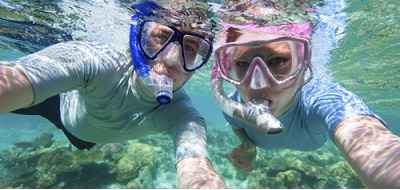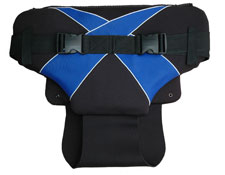Home › Diving › Lessons › Safety Tips › Snorkeling for Beginners
Snorkeling Tips for Non Swimmers
A day of snorkelling for non swimmers may raise some safety concerns. This guide explains how to stay afloat and use the correct techniques and equipment.
You do not need to be a confident or a strong swimmer to enjoy snorkeling. So, these tips and practical advice will be helpful if you haven't snorkeled before.
1. Best Life Jacket for Non Swimmer (PFD)
The first time you go snorkeling might be a conflict of emotions. You may feel buoyant excitement mixed with fearful nervousness.
In fact, trepidation could increase four-fold if you do not know how to swim or are a complete beginner at water-based activities.
Non-swimmers are unfamiliar with the basics of staying afloat. They will be unsure about using propulsion techniques in water.
Knowing how to maintain your buoyancy is the fundamental rule of water survival in the open sea environment.
As a result, wearing a personal flotation device for snorkeling in open water should be your number one priority. Hence, donning a PFD is particularly prudent if you cannot swim.
The design of snorkel vests and swimming aids increases buoyancy. So, it will help to keep your body floating on top of the water.
Let's dive in a bit deeper:
Even competent swimmers can get tired. But, because snorkeling flotation devices are meant to keep your head above water, you will be able to rest, save energy, and recover from any exhaustion.
Nonetheless from a snorkeling point of view, the encumbrances of wearing an inflatable vest around your torso can restrict your enjoyment.
Note: Wearing a snorkel vest around your waist 'upside down' can keep your body bobbing in a vertical position (e.g. for social floating in a group).
Different Types of Flotation Devices
The human body is naturally buoyant - and especially so in salty sea water. So, a device which aids buoyancy, and allows you to peer face-down in the water, would be more ideal for snorkel swimmers.
You may find that inflatable water wings or polystyrene noodle tubes work best for small children when they are splashing around in a swimming pool.
Snorkelers, surfers, swimmers, and boaters wear personal and recreational flotation devices. Even so, the different types of PFDs offer variances in the level of protection and convenience.
They are usually colored fluorescent orange or yellow and available in different accommodating sizes depending on your body weight and stature.
 Snorkel Vest for Non Swimmers
Snorkel Vest for Non Swimmers- Life Jacket or Preserver
- Flotation Waist Belt
- Mae West Buoyancy Aid
- Cork Jacket
- Flotation Suit
- Water Wings and Noodle Tubes
- Body Bobber® Neoprene Saddle (pictured below)
Non swimmers can snorkel safely after becoming familiarized with the safety equipment and basic gear essentials. For the most part, there is limited swimming required to enjoy a snorkeling tour in Pattaya, Thailand.
With a little practice, you will soon be floating on the sea's surface using a mask and snorkel, and enjoying a day around shallow coral island destinations enjoying the marine life creatures below.
Snorkeling Tip #1. Never snorkel alone! Non-swimming beginners should always wear a flotation device.
2. Using Proper Snorkeling Equipment
As a first time snorkeler, you should always try out the gear for proper fitting and comfort. Furthermore, you want to feel comfortable wearing snorkeling equipment before heading into deep water.
 Make sure the mask and snorkel are a snug fit. Wearing it too tight will be painful - and not tight enough means you could lose it.
Make sure the mask and snorkel are a snug fit. Wearing it too tight will be painful - and not tight enough means you could lose it.
Practice slow, relaxed, breathing through the plastic snorkel tube with your face looking about a 45% angle ahead (i.e. not directly down).
First timers should do this in shallow water initially. It should be an area where you can stand up if you get anxious or have breathing difficulties.
Rehearsing the skills of clearing water from the mask and snorkel while standing in knee-deep water is a great way to familiarize yourself with the equipment. Doing so will also help to build up your confidence without tiring yourself out.
You will use:
- Mask: Consider buying an optical dive mask if you wear spectacles.
- Snorkel: One that features a self-draining purge valve is best.
- Fins (also called flippers): You will use booties or thick socks with open heel fins to fit snug.
A mask, fins, and a snorkel is considered as being the least amount of gear needed to 'get your feet wet'. Hence, the basic kit consists of a dive mask, a pair of diving fins, and a snorkel tube.
There is no substitute for owning customized, or personal quality, equipment. You can buy a snorkeling set online for less than £100.
Snorkeling Tip #2. Use comfortable equipment and practice water clearing techniques in shallow water before venturing deeper.
3. Best Snorkel Destinations
The best snorkeling sites for beginners and non swimmers may not have the most active aquatic life to see and interact with (e.g. take photos).
So, learners will most likely have a better experience in shallow, calm water conditions than those requiring you to have competent swimming skills.
In case you were wondering:
Our basic guide for novice snorkelers suggests, and strongly recommends, joining an organized tour for your first experience in open water.
Newbies may also be unfamiliar with the proper boating etiquette and other activities carried out at sea. In this case, a snorkel tour conducted from a beach or shore is best for the first attempt.
Try to use a tour operator that caters for families and beginners. You will most likely receive closer attention and proper in-water supervision. Many companies also cater for non swimmers to do scuba diving activities.
Snorkeling Tip #3. Try to join a supervised snorkel tour that caters for families and groups of other non swimmers.
4. Snorkeler Buddy System
Buddy teams will usually be in pairs when they go scuba diving or snorkel diving. But, a swim team in snorkeling usually has at least three members in the group.
During a buddy system for snorkeling, two friends will swim around in the water, while a third member of the team will monitor from the shoreline or on board the boat.
Children's buddy teams should always have at least one adult present and supervising. The buddy system used by snorkelers also allows for the so-called 'one up - one down skin diving' method. This means one team member will stay on the surface while others can 'duck dive' underwater.
Snorkeling Tip #4. Ideally, a swim team in snorkeling will have at least three (3) members in the group.
5. Basic Water Survival
The annual statistics for fatalities caused by snorkeling-related activities are relatively low - compared to many other sports.
Even so, there a several predisposing medical factors that increase the likelihood of suffering an illness or dying while snorkeling.
Therefore, our final snorkeling tip for non swimming beginners relates to some general survival techniques, when in or around a body of water.
- Always snorkel in a group, and preferably one that has a high number of competent swimmers or someone experienced at making in-water rescues.
- Non-swimmers are wise to limit their snorkeling to shallow water areas (e.g. where they can stand up).
- Always wear a flotation device (PDF) and get some material protection from strong sunlight. For example, wearing a neoprene wetsuit can help you avoid many of the common aquatic life injuries.
- Stay close to the shoreline or support vessel, if you are snorkeling without knowing swimming, and nominate someone capable to supervise the group.
- Make sure at least one adult is overseeing and supervising any children who are snorkeling or near the water's edge.
Snorkeling Tip #5. A swimming pool is an excellent place for snorkeling beginners to practice.